Blog
What Is Cupping? – Part 2

In a previous blog titled “What Is Cupping? – Part 1” we discussed what cupping entails; different cupping styles; the difference between using glass or plastic cups; and how long a cupping session might last. Before continuing, we suggest you read that post as it will give you some background information about cupping.
Why do I need cupping?
At Above & Beyond Acupuncture, many patients have used cupping to help resolve a litany of physical and emotional issues. A day rarely goes by without a few patients having the cupping procedure. Given the frequency with which patients are asking for this treatment, we thought it might be helpful to expand on the earlier blog post—offering more detail as to why cupping can be very beneficial.
There are many ailments that can be resolved by using this powerful modality. A partial list would include: headaches, arthritis, colds and flu, sciatica, anxiety, depression, insomnia, chronic fatigue syndrome, lumbar/neck/shoulder pain, spasms, cramps, muscle tightness, and vertigo. [Link]
Even if you don’t have any of the issues listed above, receiving a cupping treatment can have a very relaxing effect on the body and can help promote health and wellness. From a Western perspective, cupping brings fresh blood to the area, alleviates inflammation, promotes the flow of lymph, and helps to resolve muscle adhesions. From an Eastern perspective, cupping moves blood and Qi, expels wind and dampness, resolves stagnation, and helps to bring balance to the body.
How will I feel after a cupping treatment?
Patients frequently ask what they might expect after having a cupping treatment. The answer—at least initially—is subjective; people are likely to react differently based on their physical and emotional states of being.
Nonetheless, we’d like to provide a list of some possible effects that can be experienced after a cupping treatment: relaxation, euphoria, drowsiness, hunger, thirst, slight nausea, soreness, some temporary vertigo, a feeling similar to being hung-over, a heightened sense of taste/smell/hearing, a feeling of warmness on the skin, and cravings for certain foods. Some people experience emotional releases. It is important to note that these effects are temporary and will wear off soon after the treatment. [Link]
What should I do after a cupping treatment?
Cupping is very similar to having a deep-tissue massage. In some instances, it can be a bit more intense—depending on the cupping style and strength. After a session, it is highly advisable to drink a lot of water, eat a small meal and rest/relax.
Drinking a lot of water is important, as the body will need to be hydrated. If possible, drink alkaline water, as it is more easily absorbed and integrated into the body at the cellular level.
Eating a light meal shortly after a cupping session is also beneficial. We suggest something that is easy to digest. The body will need nourishment after a cupping session, and by eating foods that are highly nutritious, it will be able to replenish and recuperate quickly.
Getting sufficient rest is vital for people who have just been cupped, and we suggest that patients make time after the treatment to relax and take it easy. This treatment style is very moving and has the potential to pull toxins out of muscle and bring them to the dermal layer where they can be properly disposed of. This process can be taxing on the body, so rest and relaxation afterward are important. There is also a possibility that some patients will have an emotional release after the treatment. If this is the case, then taking ample time to recover is vital and needs to be made a priority.
We hope this blog post has been informative about cupping and its possible effects. If you are interested in having a session or have further questions, please contact us via email or phone call. We believe that cupping is something that should be experienced by everyone. It’s a unique experience that can be extremely therapeutic.









